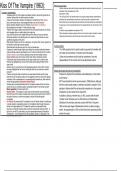Summary
Summary EDUQAS A_Level Media; Kiss Of The Vampire
- Module
- Kiss of The Vampire
- Institution
- WJEC
An in depth summary of the A-Level EDUQAS Media Topic of 'Kiss of The Vampire', written by 2 A* achieving A-Level media students. This document provides a basis of information you can build on to get an A/A* grade at A-Level. As well as this, this document provides some more in depth information a...
[Show more]



